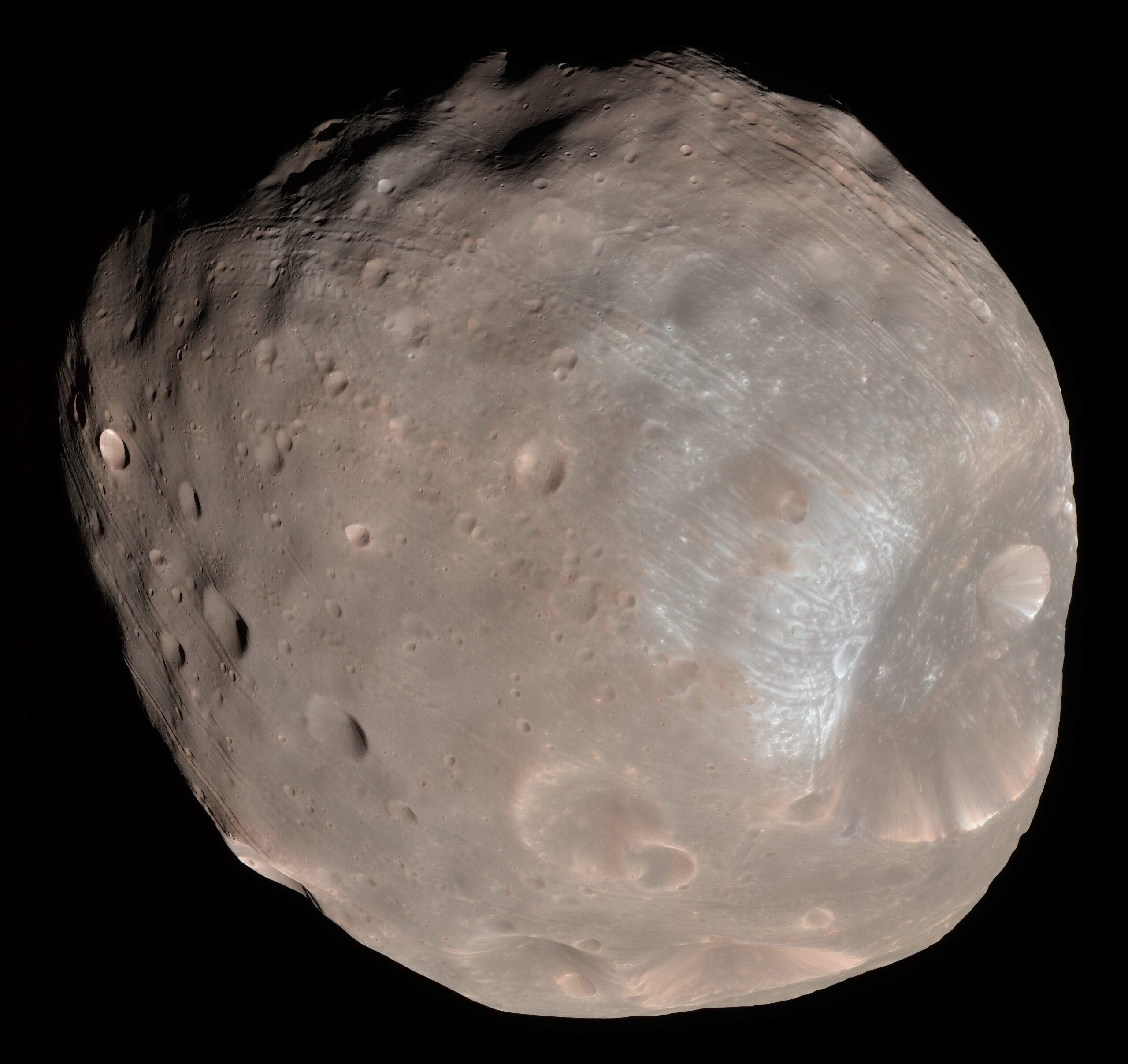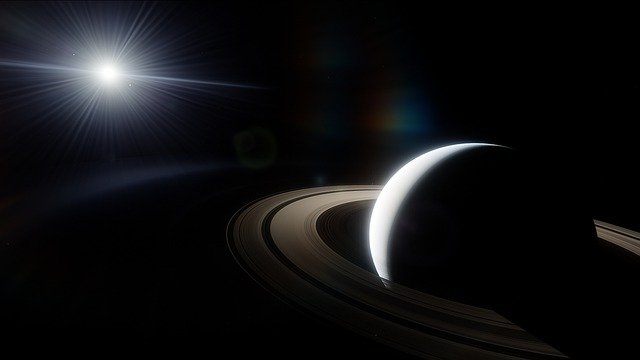*This post may contain affiliate links. This means we may make a commission if you purchase an item using one of our links*
The main differences between Saturn and Phobos are that Saturn is a gas giant planet while Phobos is a natural satellite, Phobos orbits Mars while Saturn has 81 moons orbiting it, Saturn is significatly larger with a diameter of 116,460km compared to Phobos’ is 22.53km and Saturn has 7 very visible rings orbiting it while Phobos doesn’t have any rings.
There are various other differences between the two so, continue reading if you want a more detailed look at each body along with their similarities and differences below.
What Is The Moon Phobos?
Table of Contents

Phobos is the larger and innermost of the Martian moons, named after the Greek God of fear and panic. This rocky satellite measures approximately 27 x 22 x 18 kilometers and possesses an irregular shape.
Flying only 270 km above Mars’s surface, Phobos orbits the Martian surface so closely that it spins around the planet three times a day (each orbit takes 7 hours and 39 minutes). And this proximity means that the moon cannot always be seen from Mars’ surface (it all depends on where you’re standing).
In general, Phobos rises in the west, passes through the sky in around 4 hours, and sets in the east. And this process occurs twice during one Martian day.
Phobos travels 1.8 m closer to Mars every 100 years, which means this doomed moon will one day crash into its planet or break up into rings. Still, this won’t happen for another 50 million years or so.
The moon is covered in streak patterns from impact craters, the most significant of which is the crater Stickney, with a diameter of 9.7 km. Phobos has weathered thousands of meteorite impacts, one of which almost shattered it to pieces.
It was first discovered by the American astronomer Asaph Hall on 17th August 1877. But, it can be difficult for astronomers to see as it is one of the least reflective bodies in the solar system with an albedo of 0.071.
Despite its small stature, Phobos experiences wildly varying temperatures on its dark side compared to the light side. Measurements on the light side of the moon suggest that temperatures can rise to -4 degrees Celsius, a sort of brisk winter’s day that would be cold but tolerable.
In contrast, temperatures on the dark side can drop to -112 degrees Celsius, even though the two areas are just a few kilometers apart. The probable cause is fine surface dust that cannot retain heat, allowing temperatures to drop rapidly.
The low density of Phobos suggests its composition is similar to carbonaceous chondrite meteorites, which could mean that Phobos is a captured asteroid.
What Is The Planet Saturn?

Saturn is the second largest planet in our solar system, that has a multitude of rings surrounding its gaseous exterior. It’s also the 6th farthest planet from the Sun.
As Saturn falls under the gas giant moniker, the planet is mostly made up of gases. However, Saturn’s composition is a little different from Jupiter’s where its atmosphere is mixture of hydrogen and ices containing elements of Ammonia.
It’s core on the other hand is comprised of a dense core of nickel and iron, which is then surrounded by rocks compressed so strongly that it can tends to reach scorching hot temperatures of 11,700+ degrees celsius.
On the other hand, It’s gaseous atmosphere is far cooler. The exterior generally sits in the extreme sub zero range where Saturn’s temperatures is -138 degrees celsius.
This is generally constant throughout the yellow ringed giants day to day. In fact it’s much colder than even the coldest place on Earth, which would be Eastern Antarctic Plateau, Antarctica that hits -94 degrees Celsius, which is more than 40 degrees celsius warmer.
Being so large (116,460km), Saturn’s gravitational pull is obviously strong. That’s why over it’s 4.5 billion years of existence, beyond its rings this yellow gas giant has managed to accumulate 82 different moons along with other smaller interstellar debris that now orbit it.
In fact it’s largest moon Titan is literally bigger than one of the 8 planets orbiting the Sun, Mercury.
Saturn also orbits the Sun but, as the 6th farthest planet from it, it does mean a singular orbit will take it 29.4 Earth years to complete. In comparison to its axial orbit which only takes 10.7 hours, this is an extremely long time.
Similarities Between Phobos And Saturn
There are a few similarities that Saturn and Phobos share, which in this case includes the following:
- Both are part of the same solar system.
- Neither have tectonic plates.
- Both orbit another larger object.
Differences Between Phobos And Saturn
As for the differences between the two so, they include the below:
- Phobos orbits Mars whilst Saturn only orbits the Sun.
- Saturn is a spherical shape while Phobos is not.
- Saturn has 7 distingishable rings surrounding it while Phobos has 0.
- Saturn is a gas giant planet whilst Phobos is a terrestrial based natural satellite.
- Saturn has a diameter of 116,460km whilst Phobos has a diameter of 22.53km.
- Phobos has no atmosphere whilst Saturn is gas based and therefore, is composed of hydrogen and helium.
- A day on Phobos takes 7 hours 39 minutes whilst a Saturn day is 10 hours.
- It takes Phobos 7 hours 39 minutes to orbit Mars and around the Sun in 687 days whilst Saturn orbits the Sun in 29.4 years.
- Saturn has an axial tilt of 26.73 degrees whilst Phobos’ axial tilt is closer to 0.
- Phobos’ temperature ranges between -4 to -112 degrees Celsius whilst Saturn has an average temperature of -138 degrees Celsius.
- Saturn has 81 moons while Phobos has no moons orbiting it.
- Saturn’s density is 0.687 g/cm³ whilst Phobo’s density is 1.88 g/cm³.
- Saturn’s mass is 5.683 × 10^26 kg whilst Phobos’ mass is 10.6 × 10^15 kg.
- Phobos’ gravitational strength is 0.0057 m/s² whilst Saturn’s is 10.44 m/s².
- Phobos is tidally locked to Mars whilst Saturn is not tidally locked to anything.
- Phobos only orbits Mars 6,000km away and is getting closer to the planet by 1.8 meters every 100 years.
- Saturn has magnetosphere whilst Phobos has no magnetic field.
- Saturn has a hotter central core while Phobos does not.
Summary
Saturn and Phobos share very few similarities, which would include them being a part of the same solar system and having no tectonic activity although, when it comes to their differences it is quite a vast list.
Whether it be in regards to mass, size, physical composition, orbital period, density and more they differ significantly, which is why Saturn looks and functions so distinctly from Phobos and vice versa.


